Online marketplace eBay (NASDAQ:EBAY) announced better-than-expected results in Q1 CY2024, with revenue up 1.8% year on year to $2.56 billion. On the other hand, next quarter's revenue guidance of $2.52 billion was less impressive, coming in 1.6% below analysts' estimates. It made a non-GAAP profit of $1.25 per share, improving from its profit of $1.11 per share in the same quarter last year.
eBay (EBAY) Q1 CY2024 Highlights:
- Revenue: $2.56 billion vs analyst estimates of $2.53 billion (small beat)
- EPS (non-GAAP): $1.25 vs analyst estimates of $1.20 (4% beat)
- Revenue Guidance for Q2 CY2024 is $2.52 billion at the midpoint, below analyst estimates of $2.56 billion
- EPS (non-GAAP) Guidance for Q2 CY2024 is $1.13 at the midpoint, below analyst estimates of $1.14
- Gross Margin (GAAP): 72.6%, in line with the same quarter last year
- Free Cash Flow of $472 million is up from -$4 million in the previous quarter
- Active Buyers: 132 million
- Market Capitalization: $26.1 billion
Originally known as the first online auction site, eBay (NASDAQ:EBAY) is one of the world’s largest online marketplaces.
eBay is an online marketplace that aggregates buyers and sellers to facilitate online transactions globally. The company owns no warehouses, takes no inventory risk, and does not operate a supply chain network. While it began as an auction website for used goods and collectibles, today, fixed-price goods account for a large majority of products sold.
Its value proposition to consumers still flows from its historical emphasis on hard-to-find collectibles, auto parts, and other unique items, which earned it a reputation for the widest selection to consumers. These days one can buy almost anything on eBay, from used cars to electronics and fashion. For sellers, eBay provides a large global audience for their merchandise, while also offering a range of tools and analytics to manage their online businesses.
In 2020, eBay completed the divestiture of StubHub to viagogo, receiving ~$4.05 billion in cash. This was followed by the 2021 divestitures of its classifieds business to Adevinta for ~$9.2 billion and Korea business to Shinsegae Group for ~$3.6 billion. These deals were executed to allow eBay to focus on its core marketplace business, streamline its operations, and allocate resources more efficiently. As you will see in our report, the divestitures impact the company's historical financial performance.
Online Marketplace
Marketplaces have existed for centuries. Where once it was a main street in a small town or a mall in the suburbs, sellers benefitted from proximity to one another because they could draw customers by offering convenience and selection. Today, a myriad of online marketplaces fulfill that same role, aggregating large customer bases, which attracts commission-paying sellers, generating flywheel scale effects that feed back into further customer acquisition.
eBay (NASDAQ:EBAY) competes with a range of e-commerce companies such as Amazon (NASDAQ:AMZN), Walmart (NYSE:WMT), Etsy (NASDAQ:ETSY), and OfferUp (private). Social networking company Meta is also a competitor through its Facebook Marketplace app (NASDAQ:META).
Sales Growth
eBay's revenue growth over the last three years has been unimpressive, averaging 1.8% annually. This quarter, eBay reported lacklustre 1.8% year-on-year revenue growth, in line with analysts' expectations.
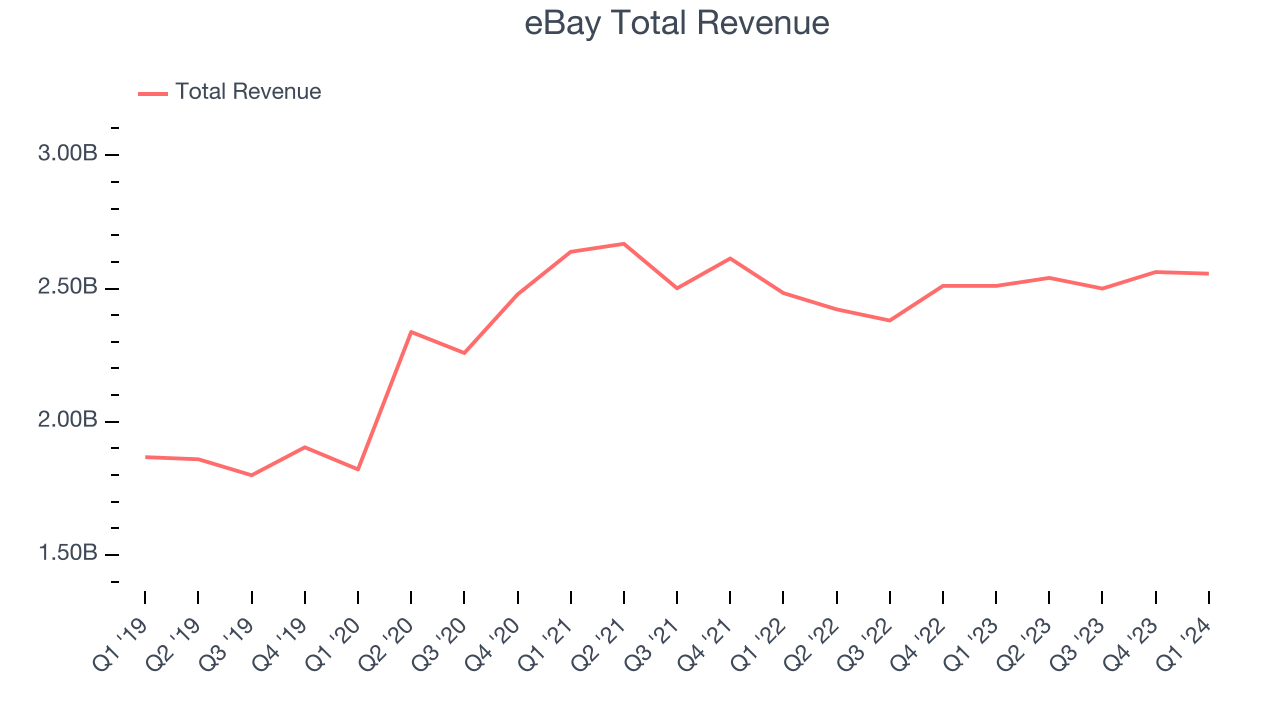
eBay is expecting next quarter's revenue to decline 1% year on year to $2.52 billion, a reversal from the 4.9% year-on-year increase it recorded in the comparable quarter last year. Ahead of the earnings results, analysts were projecting sales to grow 2.1% over the next 12 months.
Revenue Per Buyer
Average revenue per buyer (ARPB) is a critical metric to track for consumer internet businesses like eBay because it measures how much the company earns in transaction fees from each buyer. Furthermore, ARPB gives us unique insights as it's a function of a user's average order size and eBay's take rate, or "cut", on each order.
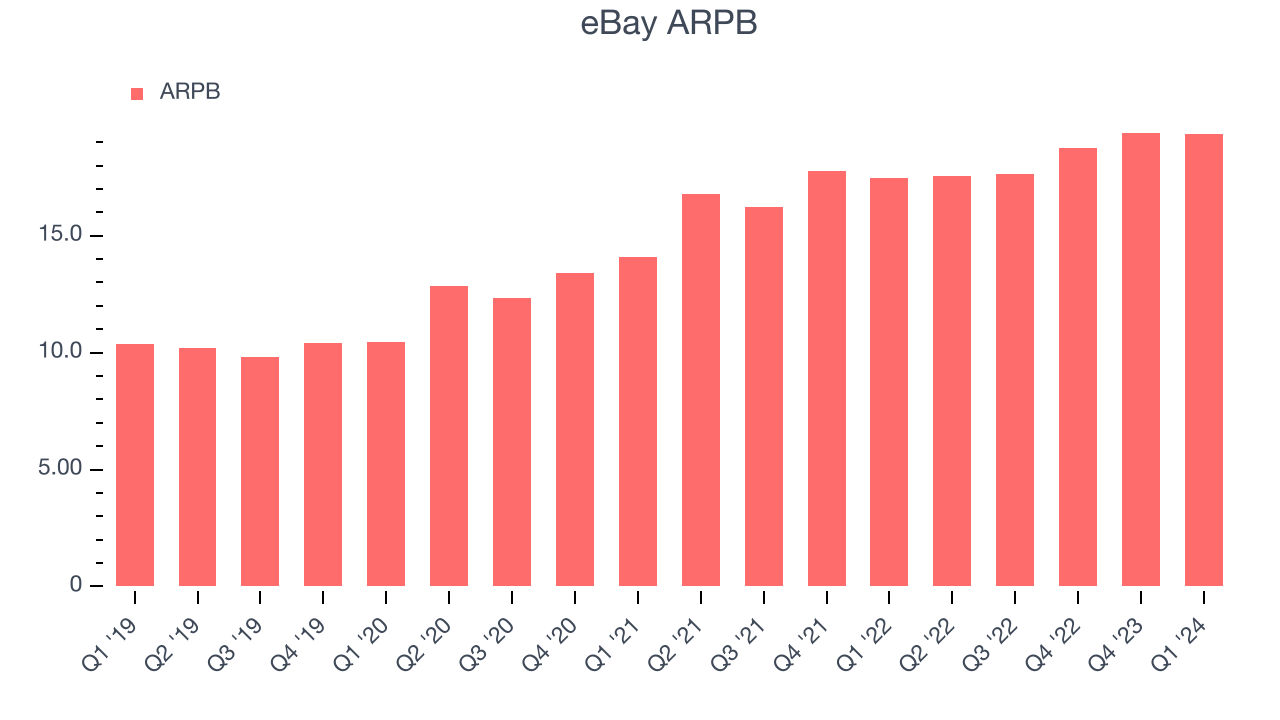
eBay's ARPB growth has been decent over the last two years, averaging 5.5%. Although its active buyers have shrunk during this time, the company's ability to increase prices demonstrates its platform's value for existing buyers. This quarter, ARPB declined NaN% year on year to $19.36 per buyer.
Pricing Power
A company's gross profit margin has a major impact on its ability to exert pricing power, develop new products, and invest in marketing. These factors may ultimately determine the winner in a competitive market, making it a critical metric to track for the long-term investor.
eBay's gross profit margin, which tells us how much money the company gets to keep after covering the base cost of its products and services, came in at 72.6% this quarter, up 0.5 percentage points year on year.
For online marketplaces like eBay, these aforementioned costs typically include payment processing, hosting, and bandwidth fees in addition to the costs necessary to onboard buyers and sellers, such as identity verification. After paying for these expenses, eBay had $0.73 for every $1 in revenue to invest in marketing, talent, and the development of new products and services.
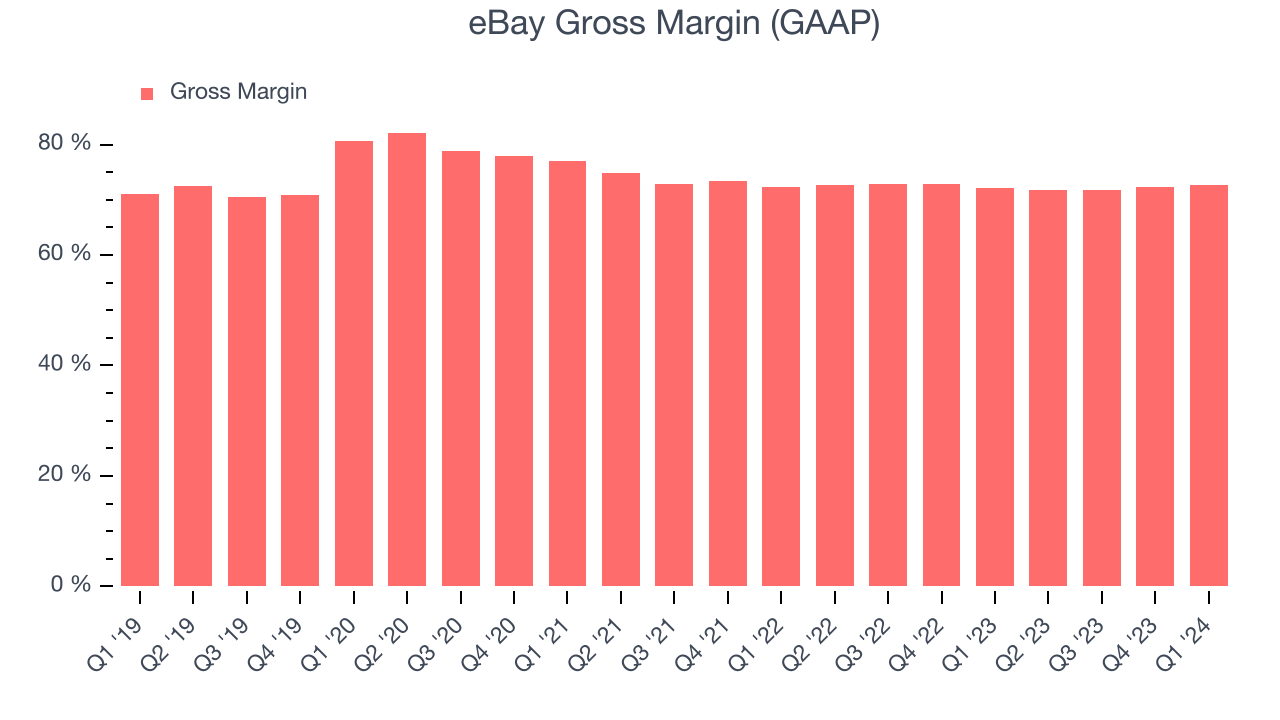
eBay's gross margins have been stable over the past year, averaging 72.1%. These robust unit economics, driven by the company's asset-lite business model and strong pricing power, are higher than its peer group and allow eBay to make more investments in product and marketing.
User Acquisition Efficiency
Consumer internet businesses like eBay grow from a combination of product virality, paid advertisement, and incentives (unlike enterprise software products, which are often sold by dedicated sales teams).
eBay is quite efficient at acquiring new users, spending only 30.7% of its gross profit on sales and marketing expenses over the last year. This efficiency indicates that eBay has a highly differentiated product offering, giving it the freedom to invest its resources into new growth initiatives.
Profitability & Free Cash Flow
Investors frequently analyze operating income to understand a business's core profitability. Similar to operating income, adjusted EBITDA is the most common profitability metric for consumer internet companies because it removes various one-time or non-cash expenses, offering a more normalized view of a company's profit potential.
eBay's EBITDA was $853 million this quarter, translating into a 33.4% margin. Additionally, eBay has demonstrated extremely high profitability over the last four quarters, with average EBITDA margins of 31.3%.
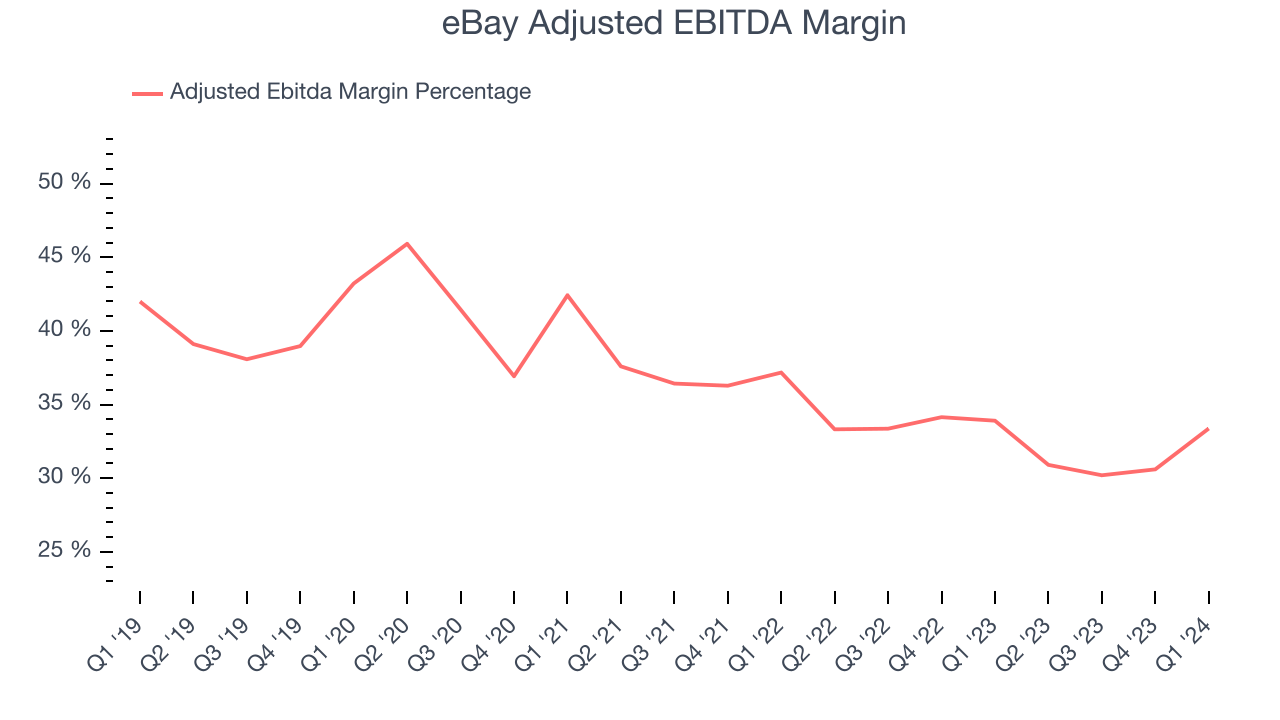
If you've followed StockStory for a while, you know that we emphasize free cash flow. Why, you ask? We believe that in the end, cash is king, and you can't use accounting profits to pay the bills. eBay's free cash flow came in at $472 million in Q1, down 33.4% year on year.
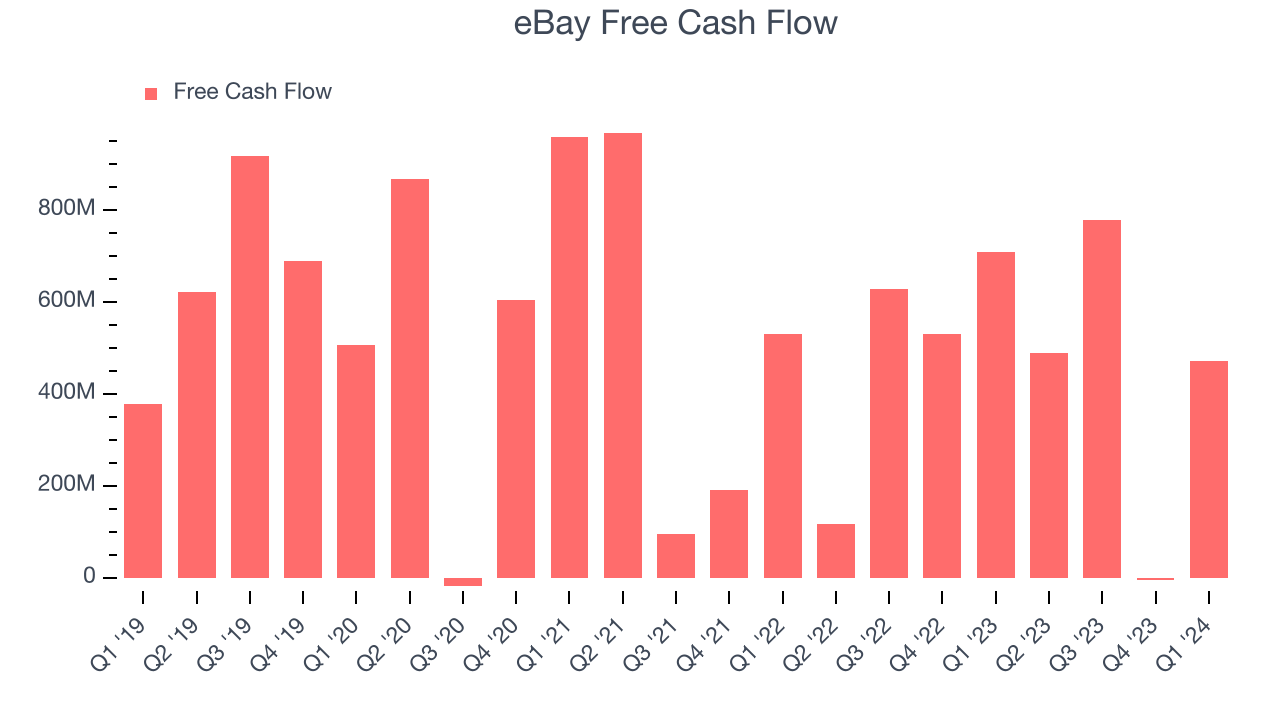
eBay has generated $1.73 billion in free cash flow over the last 12 months, an impressive 17.1% of revenue. This high FCF margin stems from its asset-lite business model and strong competitive positioning, giving it the option to return capital to shareholders or reinvest in its business while maintaining a cash cushion.
Balance Sheet Risk
Debt is a tool that can boost company returns but presents risks if used irresponsibly.
eBay reported $3.87 billion of cash and $8.09 billion of debt on its balance sheet in the most recent quarter. As investors in high-quality companies, we primarily focus on two things: 1) that a company's debt level isn't too high and 2) that its interest payments are not excessively burdening the business.
With $3.18 billion of EBITDA over the last 12 months, we view eBay's 1.3x net-debt-to-EBITDA ratio as safe. We also see its $32 million of annual interest expenses as appropriate. The company's profits give it plenty of breathing room, allowing it to continue investing in new initiatives.
Key Takeaways from eBay's Q1 Results
Results in the quarter were fine, with revenue and EPS exceeding expectations. However, revenue growth was quite weak. Adding to the bad news is the fact that both the company's revenue and EPS guidance for next quarter missed analysts' expectations. Overall, the results could have been better. The company is down 6% on the results and currently trades at $48 per share.
Is Now The Time?
eBay may have had a bad quarter, but investors should also consider its valuation and business qualities when assessing the investment opportunity.
Although eBay isn't a bad business, it probably wouldn't be one of our picks. Its revenue growth has been weak over the last three years, and analysts expect growth to deteriorate from here. And while its gross margins are a strong starting point for the overall profitability of the business, unfortunately, its active buyers have declined.
At the moment, eBay trades at 8.0x next 12 months EV-to-EBITDA. In the end, beauty is in the eye of the beholder. While eBay wouldn't be our first pick, if you like the business, the shares are trading at a pretty interesting price right now.
Wall Street analysts covering the company had a one-year price target of $51.16 per share right before these results (compared to the current share price of $48).
To get the best start with StockStory check out our most recent Stock picks, and then sign up to our earnings alerts by adding companies to your watchlist here. We typically have the quarterly earnings results analyzed within seconds of the data being released, and especially for the companies reporting pre-market, this often gives investors the chance to react to the results before the market has fully absorbed the information.
